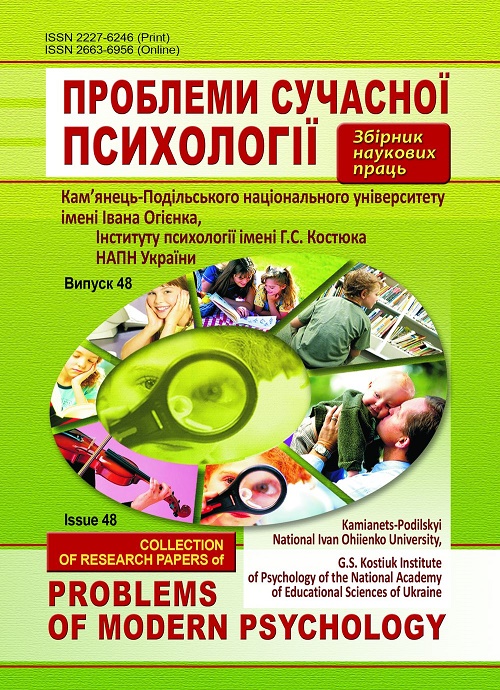The Role of the Emotional Intelligence in Making Materials More Contextually Appropriate
DOI:
https://doi.org/10.32626/2227-6246.2020-48.112-132Keywords:
emotional intelligence, peculiarities of perception, perceptually-emotive component of communicative techniques, self-consciousness, social awareness, self-government, social skills.Abstract
The purpose of the research is to provide theoretical justification and practical
development of the perceptually-emotive component of communicative
techniques as the ways of making materials more context appropriate. The last
one in a great degree influences on the development of emotional intelligence
of the person.
Methods of the research. The following theoretical methods of the research
were used to solve the tasks formulated in the article: a categorical method,
structural and functional methods, the methods of the analysis, systematization,
modeling, generalization.
The results of the research. Emotions and perceptions in organizing a
lesson of foreign languages were entrusted into many of the alternative and
game techniques, pedestal and intensive ones. Heuristic learning is always open,
which gives each teacher a space for creativity, develops and strengthens the
pupils’ perception of the educational material, the perception of school and a
lesson as a whole. The educational material is considered and presented as a
heuristic one. Only under this condition when the assimilation of the material
takes place simultaneously at the level of data of two spheres – emotional and
perceptual – we can tell about actualizing the emotional intelligence of the
person. At the same time, the actual educational material is supplemented with
positive background information in order to combine associative relationships
with the positive emotions and emotional experiences, in particular among
teenagers.
Emotional intelligence is the integrative concept and it includes a multitude
of varied abilities, knowledge and skills, the importance and necessity of
the development of which does not call into questions of psychologists and
teachers. Researchers offer different variants of the structure of the emotional
intelligence and conduct discussions about the components of this concept.
Among the components of emotional intelligence, the authors singled out such
abilities, as: 1) perception of emotions (identification of emotions by persons, in
design, in music, in stories); 2) emotional assistance (transference of feelings,
decision making on basis of emotions); 3) emotional understanding (definition
of the subject of emotions, mixing the emotions, emotional transfer, emotional
perspectives); 4) emotional control (managing one’s own emotions, managing
emotions of others).
Conclusions. In our research we proposed the following components of
emotional intelligence: 1) self-consciousness (emotional self-consciusness,
self-esteem, self-confidence); 2) social awareness (empathy, organizational
awareness, self-orientation); 3) self-government (self-control, adaptability, initiative,
orientation towards achievement); 4) social skills (leadership, influence,
communication, actualization of personal changes, the behavior in conflict
situations, the activity within micro-groups, link building).
It was shown that there were absolutely precise ways of determining
different types of cognitive activity. Each person peculiarly combines different
types of cognitive activity, each child has his / her own individual type of
knowledge, which must correspond to their style of learning. Therefore, the
main attention when working on the basis of the heuristic approach should be
paid not to determine the type of cognitive activity of each pupil, but to use such
a style of learning, in which pupils will be involved into various types of cognitive
activity.
Before answering the teacher’s questions, the pupil must extract the
information required for the answer. It can be in the form of visual, auditory and
kinesthetic (based on muscle senses) images. These processes occur at the level
of consciousness. Then perceived information should also be presented visually,
auditory and kinesthetically. This is a conscious action.
References
Cмульсон М. Л. Проектування дистанційних розвивальних середовищ. 2016. URL : psytir.org.ua/index.php/technology.../22/6.
Смульсон М. Л. Структура інтелекту: рефлексія та інтуїція. Психологія: Збірник наукових праць НПУ ім. М. П. Драгоманова. Київ, 2000. Вип. 11. С. 9–16.
Gardner, H. (1993). Multiple intelligences: the theory in practice. New York : Basic Books. 463 p.
Honcharuk, N., & Onufriieva, L. (2018). Communicative needs in the structure of the intercourse process. Fundamental and Applied Researches in Practice of Leading Scientific Schools, 27 (3), 111–116. URL : https://farplss.org/index.php/journal/article/view/373.
Mykhalchuk, N. O. (2017). Psychological context of the idea of understanding. Психолінгвістика. Психолингвистика. Psycholinguistics. 2017. Вип. 22 (1). С. 163–175.
Downloads
Published
How to Cite
Issue
Section
License
Copyright
The Editorial Board has the full right to publish original scientific papers containing results of theoretical and experimental research works which are not currently subject to review for publication in other scientific editions. The Author shall transfer to the editorial board of the Collection the right to spread the electronic version of the paper, as well as the electronic version of the paper translated into English (for papers originally submitted in Ukrainian and Russian) by all kinds of electronic means (placement at the official website of the Collection, electronic databases, repositories etc).
The Author of an article reserves the right to use materials of the paper, without approval with the editorial board and the founders of this Collection: a) partially or fully, for educational purposes; b) for writing own dissertation papers; c) for preparation of abstracts, conference reports and presentations.
The Author of an article can place electronic copies of the paper (including the final electronic version downloaded from the official website of the Collection) at:
- personal web resources of all Authors (websites, webpages, blogs etc.);
- web resources of the institutions where the Authors are employed (including electronic institutional repositories);
- non-profit public access web resources (for example, arXiv.org).
But in all cases, it is obligatory to have a bibliographic reference to the paper, or a hyperlink to its electronic copy placed at the official website of this Collection.






